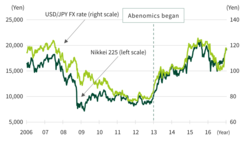7. Abenomics and Treasury Unit's nimble portfolio management
In December 2012, the general election of the House of Representatives (the lower house of the National Diet) brought to power the Liberal Democratic Party and its coalition partner New Komeito. The new administration was led by Shinzo Abe, who served a second stint as prime minister of Japan. It launched a set of economic policies known as Abenomics, which centered on three arrows of drastic monetary easing (first arrow), flexible fiscal stimulus (second arrow), and growth strategies to encourage private investment (third arrow). In line with these policies, the Bank of Japan (BOJ) initiated its quantitative and qualitative monetary easing policy in April 2013.
The announcement of Abenomics gave rise to expectations for the Japanese economy to come out of the deflationary spiral and head toward recovery, which was reflected in a jump in the Nikkei 225 from 10,395 at the end of 2012 to 12,397 at the end of March 2013. In the foreign exchange market, the excessive yen appreciation was unwound. The Japanese yen was appreciated from the summer of 2011 to break through the 80-yen-per-dollar threshold before abruptly beginning to depreciate due to the announced new economic policies, falling past 100 per dollar in May 2013.
SMBC’s Treasury Unit quickly responded to the abovementioned major policy changes brought by the new administration, and substantially reorganized portfolios in a timely manner. Specifically, anticipating a decline in returns on Japanese government bonds, stronger domestic stock markets, and a depreciation of the yen, the Unit reduced the Japanese bond portfolio while increasing investment in Japanese stocks (stock index) and expanding positions to take advantage of the movement in foreign exchange.
Subsequently, responding to the BOJ’s additional monetary easing measures, the yen further weakened to reach 120 yen per dollar, and the Nikkei 225 exceeded 17,000 at the end of 2014 and reached over 20,000 in April 2015 for the first time in 15 years, the last time being in April 2000. Once again, the Treasury Unit effectively captured the phase of the strong domestic stock market and the trend toward a weaker yen to contribute to increasing the net business profit of SMFG.

-
Chapter 1The Financial Crisis and Realignment of the Financial Sector
-
Chapter 2The Birth of SMBC and SMFG
-
Chapter 3Initiatives Pursued by SMBC Banking Units in the Early Years
-
Chapter 3Initiatives Pursued by SMBC Banking Units in the Early Years
-
- Enhancing our retail consulting and payments & consumer finance businesses
- Enhancing corporate financial solutions
- Banking-Securities collaboration in the wholesale securities business
- Challenges facing our global banking business
- Actions by Treasury Unit in preparation for rising interest rates
- Integration of operating systems and administrative functions
-
-
-
Chapter 4Embarking on Fresh Challenges Under New Leadership
-
Chapter 4Embarking on Fresh Challenges Under New Leadership
-
- Changes of leadership and the announcement of our new management policy
- Developing group business strategies
- Addressing antitrust issues
- Completing repayment of public funds
- LEAD THE VALUE
- Enhancing our retail financial consulting business
- Enhancing our corporate solution business
- Enhancing our investment banking business
- Global banking business turnaround
- Upgrading risk management in preparation for Basel II
- Development of human resources
- CSR activities
-
-
-
Chapter 5SMFG’s Response to Global Economic and Financial Turmoil
-
Chapter 6Preparing for the Next Decade
-
Chapter 1Business Model Reform Under Challenging Business Conditions
-
Chapter 1Business Model Reform Under Challenging Business Conditions
-
- Our journey under new leadership (the second decade)
- Focusing on growth industries and businesses
- Reforming domestic business operations
- Promoting banking-securities collaboration in Wholesale Banking Unit
- Structural reform of our retail business
- Meeting the needs of an aging society
- Abenomics and Treasury Unit's nimble portfolio management
- Operating in a negative-interest-rate environment
-
-
-
Chapter 2Enhancing Group Businesses
-
Chapter 3Expanding Our Global Business
-
Chapter 4Enhancing Corporate Infrastructure Under a New Governance Framework
-
Chapter 4Enhancing Corporate Infrastructure Under a New Governance Framework
-
- New leadership and enhancing corporate governance
- Introducing group-wide business units and CxO system
- Improving capital, asset, and cost efficiency
- Pursuing our cashless payment strategies
- Retail branch reorganization
- Customer-oriented business conduct
- Enhancing internal-control frameworks
- Valuing diversity and revision of our HR framework
-
-
-
Chapter 5The Path for Our Future
-
Chapter 6Opening a New Chapter in SMBC Group’s History
